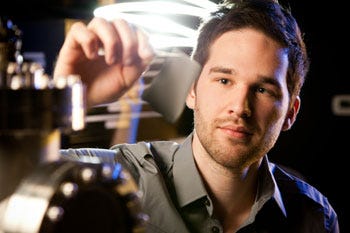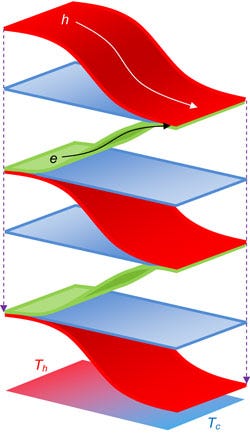Thermoelectric Felt Has Medical Device Power All Wrapped Up
A low-cost felt from Wake Forrest University (Winston-Salem, NC) converts heat differences into electrical power. It could use body heat to power pacemakers and provide biofeedback sensors.
March 16, 2012
|
Wake Forest graduate student Corey Hewitt holds a piece of Power Felt. |
A low-cost felt from Wake Forrest University (Winston-Salem, NC) converts heat differences into electrical power. It could use body heat to power pacemakers and provide biofeedback sensors when integrated with radio-frequency identification technology, according to David Carroll who leads the research team that created the material at the Center for Nanotechnology and Molecular Materials.
“Our bodies generate a lot of energy that we don’t use,” Carroll says. “By scavenging this body power, we can make electricity that won’t run out.”
Carroll points to various applications that his team is working with partners to develop, such as integrating it into clothing and other materials. “You could potentially power a diagnostic device using the bed sheets a patient is lying on,” he says. In places where power isn’t readily available, such textiles could be invaluable.
|
The multilayer film consists of alternating p-type (red) and n-type (green) thin films with insulating polymer films (blue) between the conduction layers. In the p-type layers, the charge carriers are holes (h). The “hot” holes will travel through the p-layer from the hot side (T_h) to the cold side (T_c). In the n-type layers, electrons (e) carry the charge. |
Additional uses might include employing the material to sense changes in body temperature or positioning. Traumatized tissue for a burn victim, Carroll explains, has temperature fluctuations at different stages of healing. Monitoring those changes provide biofeedback to wound care providers.
The felt comprises carbon nanotubes in plastic fibers. It is then treated to mimic the feel of fabric. Body heat is enough to generate nW or µW of power per square inch, says Carroll. And although that may not seem like much, “if you need more power, all you have to do is make a larger piece of material,” he explains. People often think of the material as a battery, but it’s more like a solar panel.
The multilayer film is composed of alternating p-type and n-type nanotube (n-type) and polymer (p type) heterogeneous films, which are less than 20 µm thick. Insulating polymer films are placed between the conduction layers. These layers are pressed together vertically and heated to ~425 K to melt the polymer enough to bond the layers together. The completed film is subjected to a temperature gradient, to create a positive potential difference read across the first and last conducting layers governed by the Seebeck Coefficient (the principle that electrons carry both electricity and heat) of the multilayer film. In the p-type layers, the charge carriers are holes. The “hot” holes travel through the p-layer from the hot side to the cold side. In the n-type layers, the charge carriers are electrons. The “hot” electrons travel through the n-layer from the hot side to the cold side. The alternating p/n layers with p/n junctions at opposite ends enables the direct addition of the absolute value of the Seebeck coefficient for each layer to arrive at the effective overall film Seebeck coefficient.
Carroll’s team is beginning to work with various researchers for medical applications. However, he says the biggest barrier to development is the regulatory scheme. “The device uses nano-engineered composite, and FDA, understandingly, wants to know a lot about how it will react to skin and how it will act in a land fill, for example. We have most of that data, but getting it to be used in a medical device will take deep pockets,” Carroll says. To get the best use of the material, Carroll says he is first going after low-hanging fruit—to sense communication patterns in a sensor, automobile applications (e.g., the interior fabric of the car could support batter power). But he sees a world of potential in the fabric.
“Right now, I have the material in conjunction with an RFID chip in the helmets of everyone in my son’s baseball team. They are at a high risk of heat stroke here in the South. The RFID monitors temperature change and sends a signal to my iPhone app so that I can tell if any of the kids or coaches are at risk.”
About the Author(s)
You May Also Like



.png?width=300&auto=webp&quality=80&disable=upscale)
